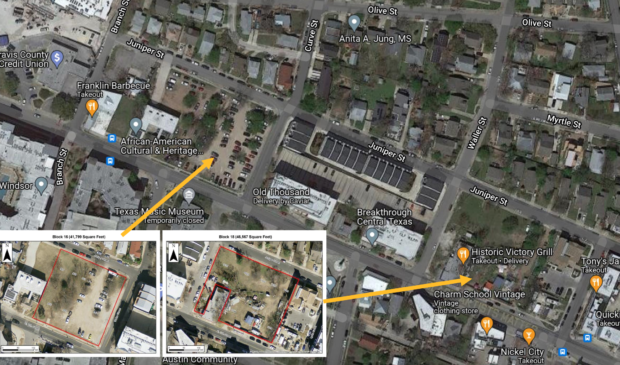Feedback fueling progress on redevelopment of blocks 16 and 18 downtown
Thursday, September 29, 2022 by
Chad Swiatecki Residents along the eastern edge of downtown Austin have had many, many opportunities through the years to share their thoughts about how the city should redevelop two blocks on East 11th Street, with not a lot to show for it. But leaders of the new quasi-governmental body leading the development process now insist change is afoot, with a request for proposals expected to be completed by the end of the year and private developers submitting their plans for evaluation next year.
An ongoing survey and virtual community feedback session on Friday are two of the ways the Austin Economic Development Corporation is gathering ideas for how best to use the East 11th Street blocks that straddle Curve and Waller streets. Through the years, the mostly vacant parcels, which are owned by the city’s Urban Renewal Board, have been identified as a preferred location for creative space, affordable housing and retail including a grocery store.
The limited acreage of the two blocks will limit what can be built there using private financing as as well as a variety of tax credits or other public money.
Anne Gatling Haynes, chief transaction officer for the EDC, said the feedback sessions are intended mostly to confirm the neighborhood needs that residents have expressed for years of scuttled redevelopment talks.
“The past hasn’t gotten in the way yet but I certainly have heard quite a bit of the distrust … which is that no one listened to us the last time, so what is going to be different this time,” she said. “Ultimately I think there might be a communication gap around the primary uses and character and making sure that we are preserving and celebrating the legacy here and moving it forward. Our approach is to open the conversation and listen since this is not a planning exercise and we do want to validate and understand the priorities of the people.”
The suggestions submitted in the coming weeks will be gathered and analyzed to determine what mix of uses and financing tools could be most feasible for the properties. The guidelines for the RFP are expected to be submitted to the Urban Renewal Board in November for a recommendation for final approval from City Council.
Theresa Alvarez, CEO and president of the EDC, said the early conversations with community members have brought consistent ideas and desires for the area, with EDC staff needing to help find the best mix of uses given existing land restrictions and development costs in Austin.
“People still want a cultural arts venue and affordable housing, which is similar to what people want across the country since those are problems that aren’t specific to one city,” she said. “The list is too long to fit on two pieces of land. On the grocery store, people have wanted HEB or some other affordable type of grocery store here for a long time, but when you look at the square footage available – unless HEB is willing to do a multilevel location – you’re looking at a smaller, less affordable grocery store.”
Manuel Escobar, chair of the URB, said he is glad to see the redevelopment process for the parcels moving forward after the board spent much time in recent years revising and aligning the urban development plan and Neighborhood Conservation Combining District overlay that regulate some of the land use guidelines in the area.
“These things tend to take longer than you’d normally expect, but up to this point we’re relatively close to the original timeline for this process,” he said. “My hope is we’ll be able to stay on that timeline as we go forward. I’ve been pleased with the AEDC … given the general instruction from Council to get these two parcels developed, and there were limitations with city process and getting off the first step. We were comfortable going with AEDC because we knew a lot of people would be reviewing their performance and there was incentive for them on this.”
The Austin Monitor’s work is made possible by donations from the community. Though our reporting covers donors from time to time, we are careful to keep business and editorial efforts separate while maintaining transparency. A complete list of donors is available here, and our code of ethics is explained here.
You're a community leader
And we’re honored you look to us for serious, in-depth news. You know a strong community needs local and dedicated watchdog reporting. We’re here for you and that won’t change. Now will you take the powerful next step and support our nonprofit news organization?



